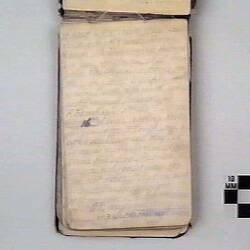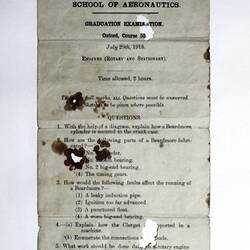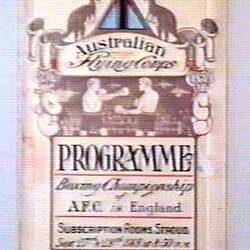Summary
World War I diary, black-covered, written by Private Alan Horner, service no. 2033, H Company, 6th Battalion, 2nd Infantry Brigade, 1st Division AIF, September 1914 - October 1915. The diary includes details regarding service in Gallipoli. A pencil and a leave pass for 8/7/19 accompany the diary.
The diary covers the period from Horner's first voyage overseas to the AIF Training Camp at Mena, Egypt and his service beyond on the Gallipoli Peninsula. Most of his early entries are about his excitment at travelling though the oceans to the Middle East, via Sri-Lanka, and the ports and people they meet on the way. The diary contains many sketches, in grey-lead pencil and soft, purple pencil, of the various coastlines, rocky landscapes, Suez Canal and geography of the areas; and later, finishes with some leaf-pressings of common plants in England, speaking to Horner's interest in Geography. This is also apparent in some of his entries about Cairo, as he explores in his leave time, with fellow AIF members, and discovers Muslim Temples, the Sphinx and Pyramids, coffee shops and everyday people in the street; commenting on what he sees and prehaps ommiting some details.
His entries following landing at Gallipoli take on a slightly more hurried and reportage-style. Although he arrived after the April 25th Anzac push, he was involved in heavy fighting, fierce shelling and the poor living conditions faced by all the Anzacs in the Dardenelles. His time post-concussion, 8/8/15, is much quiter and his subsequent time in 3rd General Hospital, Wandsworth, is hardly commented on. The diary concludes with visits to cousins in England after being discharged from Hospital, before he goes on to the Australian Army Pay Corps, and further training with the RAF.
Alan Horner was born in Castlemaine, Victoria, and became a grocer. He joined the Cadets as a youth and was serving in Area 66 as a 2nd Lieutenant when he enlisted in the AIF at the age of 18, on 11 September 1914. He embarked from Australia on 21 October 1914. His service records indicate that he joined his unit at Gallipoli on 15 May 1915, just 20 days after the first landing. Amid heavy shelling, he was concussed on 8 August, and on 10 August was admitted to the No.2 Field Ambulance Dressing Station suffering 'debility and shock'. He was transferred to a casualty clearing station, and sent to England aboard Hospital Ship Aquitana, from Mudros to London. He was admitted to Wandsworth Hospital, England, on 23 August suffering a 'disability' that was 'not stated as being serious', recovering from concussion and possibily suffering post-traumatic stress. He remained in England from that point on, and in September 1916 was attached to the AAPC (Australian Army Pay Corps). In January 1918 he was reprimanded for the offence of being 'improperly dressed', failing to wear 'chevrons and distingushing colours'. Weeks later he was admitted to hospital again, (18/1/1918-5/2/1918), this time with influenza (just prior to the 'Spanish Flu' pandemic). In May 1918 he began a cadetship with the Australian Flying Corps, and in June was an RAF cadet, 'training as flying officer (Pilot)'.
The exploding shell that concussed Horner also caused his temporary live burial in the sand, soil and rubble of the surrounding trench terrain. His stay of 10 days in the 3rd London General Hospital, Wandsworth, from 23/8/1915-1/9/1915, is not elaborated upon in his diary, although the concussion and burial incident was significant enough to warrant mentioning to hospital staff in a subsequent visit, post-war. It is interesting to note that he did not return to active service again, rather was re-assigned to the Pay Corps at Admin. Head Quarters No.2, England, (31/8/1916), and then training with the R.A.F.
He was a 2nd Corporal when repatriated to Australia via the Leicestershire from overseas in December 1918, landing on home soil on 22/1/1919. He was discharged from military service on 23 March or 13 May 1919 (some variation in dates of discharge recorded) - due to being medically unfit due to an accident while not on military service: a car accident immediatley after his return to Australia, 10/2/1919. The accident injured his right leg, with a fracture of the femur and patella, and Horner was in hospital untill 20/8/1919. This marked him as permanently unfit for General Service and he was awarded a Disability Pension of 50% for the first six months, and 25% thereafter. A steel plate was inserted to fuse the bones in his leg in 1919, but was removed some years later in 1958, following arthritis and pain in the leg. Post-war, Horner returned to work as a clerk at a grocery, residing at 36 Belmont Ave, East Malvern. At 27 years of age, he married Ms Florence Harrington in West Melbourne. Later in life, through the 1930s, he worked as a draftsman in the Australian Taxation Department, in the London Stores Building, Melbourne. After a long life in the Public Service, he passed away at age 82, due to bronchopneumonia and cardiac failure, on the 27/8/1978, at home (or nursing home?) at 26 Service St., Hampton. He was survived by his widow and his daughter, Glenna Terese Horner. He was buried at New Cheltenham Cemetery.
Physical Description
Diary, pencil and leave pass. Hand-written diary has black cover, hinged at the top, with elastic strap to hold closed (now stretched and broken). Cover has the appearance of leather, but now has significant losses, and the substrate is visible in places. Lined off-white pages, mostly written in pencil. Includes a sketch of Ismali, Egypt, including Lake Timsah.
Significance
Personal diaries provide a valuable insight into the daily life in the Australian armed forces. Some diarists record the mundane routines of daily life in military camps, or ports visited during voyages on transport ships; others provide graphic details of battles and medical treatments. Welcome letters and parcels from home are described, and friendships are recorded. Many soldiers complain about the food, or record welcome or festive meals such as Christmas. The diaries show many of the ways servicemen and women coped with the discipline, stress and tragedy of war.
More Information
-
Collection Names
Military Memorabilia Collection, Returned and Services League (RSL) Collection
-
Collecting Areas
-
Acquisition Information
Donation & Subsequent Transfer from Victorian Branch, Returned & Services League of Australia Limited (RSL), Mrs Yvonne Van Veen, Mar 1987
-
Author
Corporal Alan Horner, Gallipoli Peninsula, Dardanelles, Turkey, 1914-1915
-
Format
Book
-
Inscriptions
[Extensive text, handwritten in grey-lead pencil and purple pencil.]
-
Classification
-
Category
-
Discipline
-
Type of item
-
References
The National Archives of Australia holds Alan Horner's service records - Series accession number B2455, Barcode 5831737. The National Archives also hold information on Horner, Post-War, in Department of Veterans' Affairs Hospital and Medical Files, Series No: B73, Items 12985323, 12985324, and 12985325. National Archives Australia, Department of Veterans' Affairs Hospital Files, Part 1 and 2, B73/12985323, 12985324, and Department of Veterans' Affairs Medical Files, B73/12985325. Ancestry database. Department of Births, Deaths and Marriages Victoria.
-
Keywords
Military Memorabilia, Wars & Conflicts, World War I, 1914-1918, Making History - War Diaries and Correspondence







